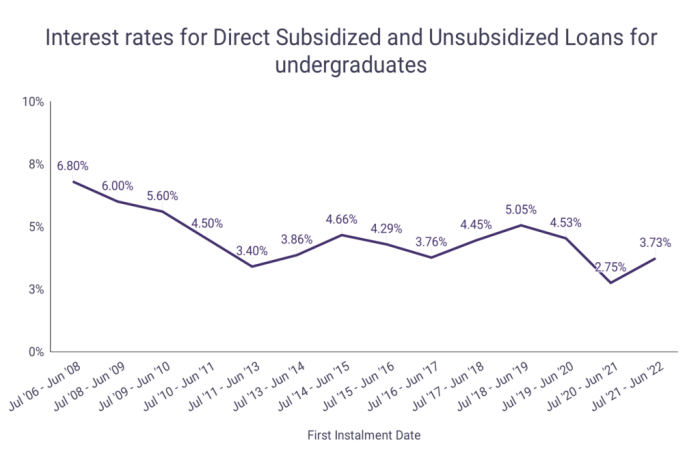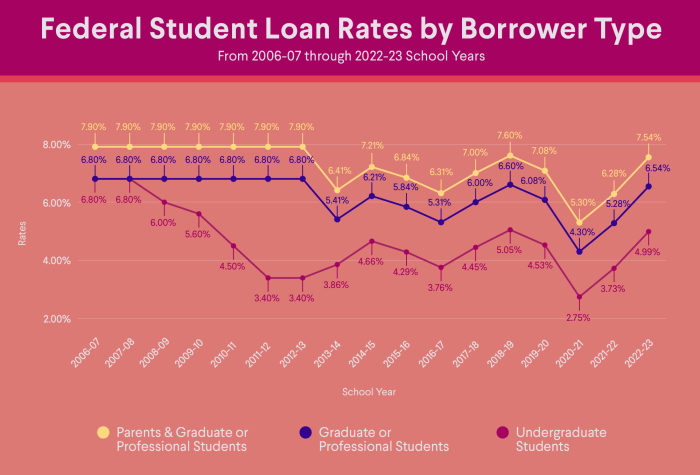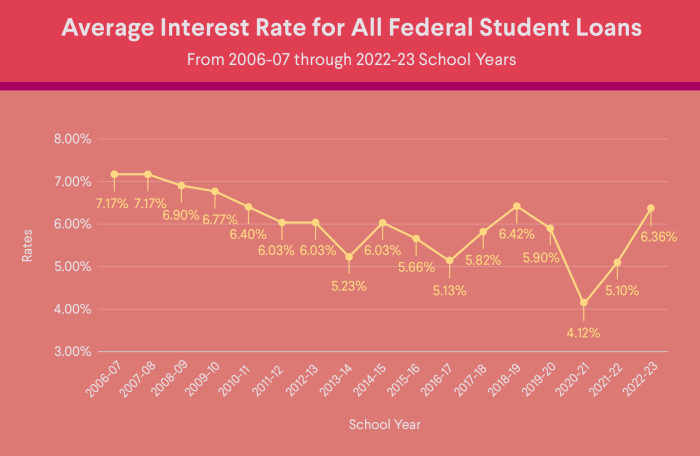
Navigating the world of student loans can feel overwhelming, especially when faced with varying interest rates. Securing the lowest possible interest rate is crucial to minimizing long-term debt and maximizing your financial future. This guide explores the intricacies of finding the best student loan options, helping you understand the factors that influence interest rates, eligibility criteria, and strategies for securing the most favorable terms.
We’ll delve into the differences between federal and private loans, examining various repayment plans and their impact on your overall cost. Understanding these nuances empowers you to make informed decisions, ultimately saving you money and reducing the financial burden of higher education.
Eligibility Criteria for Low-Interest Student Loans

Securing a student loan with the lowest possible interest rate is a crucial step in managing your educational expenses and minimizing long-term debt. Understanding the eligibility criteria for both federal and private loans is essential to navigating this process effectively. This section details the key factors influencing your eligibility for low-interest student loan options.
Federal student loans, particularly subsidized loans, generally offer the lowest interest rates available. However, eligibility hinges on several factors. Private loans, while potentially offering higher interest rates, may be accessible to borrowers who don’t meet the requirements for federal aid.
Federal Student Loan Eligibility
Eligibility for federal student loans with the lowest interest rates primarily depends on demonstrating financial need and maintaining satisfactory academic progress. Applicants must be enrolled or accepted for enrollment at least half-time in an eligible degree or certificate program at a participating institution. Furthermore, they must be a U.S. citizen or eligible non-citizen, and complete the Free Application for Federal Student Aid (FAFSA) form accurately and on time. The FAFSA assesses your financial need based on factors like family income, assets, and the number of dependents. A lower demonstrated need may result in receiving a lower loan amount, but does not necessarily mean a higher interest rate for the loans you do receive. Maintaining satisfactory academic progress, usually defined by a minimum GPA and course completion rate, is also crucial for continued eligibility.
Credit History and Private Student Loans
Unlike federal student loans, private student loans often consider your credit history significantly. A strong credit history, characterized by responsible borrowing and timely payments, is often a prerequisite for securing the most favorable interest rates. Individuals with limited or poor credit history may face higher interest rates or even be denied a loan altogether. For example, a student with a history of missed payments or high credit utilization might be offered a loan with a significantly higher interest rate compared to a student with an excellent credit score and history of responsible credit use. Co-signers with good credit can sometimes help students with limited credit history qualify for lower interest rates.
Income-Based Repayment Plans
Income-driven repayment (IDR) plans are available for federal student loans and can significantly impact the total interest paid over the life of the loan. These plans calculate your monthly payments based on your income and family size. While your monthly payments might be lower under an IDR plan, the overall repayment period may be extended, potentially leading to a higher total interest paid compared to a standard repayment plan. For example, a borrower with a lower income might choose an IDR plan with smaller monthly payments, but may end up paying more interest over the 20-25 year repayment period. However, the benefit of a lower monthly payment can significantly ease the financial burden during the repayment period.
Federal Student Loan Application Process
The following flowchart illustrates the typical application process for federal student loans:
[Flowchart Description: The flowchart begins with “Complete the FAFSA.” This leads to “Receive Student Aid Report (SAR).” The SAR then branches to “Eligible for Federal Student Aid” and “Ineligible for Federal Student Aid.” The “Eligible” branch leads to “Select Loan Type and Amount,” followed by “Complete Master Promissory Note (MPN),” then “Loan Funds Disbursed.” The “Ineligible” branch leads to “Explore Alternative Funding Options.”]
Hidden Costs and Fees Associated with Student Loans

Securing a student loan might seem straightforward, but understanding the complete financial picture goes beyond the advertised interest rate. Several hidden fees and costs can significantly increase the total amount you repay, impacting your long-term financial health. It’s crucial to be aware of these potential expenses before signing any loan agreements.
While the interest rate is a major factor influencing your loan’s overall cost, several other fees can add up substantially. These additional charges can make a significant difference in the total amount you ultimately pay back, potentially stretching your repayment period and increasing the overall burden. Failing to account for these hidden costs can lead to unexpected financial strain after graduation.
Origination Fees
Origination fees are charges levied by the lender to process your loan application. These fees are typically a percentage of the total loan amount and are deducted from the funds disbursed to you. For example, a 1% origination fee on a $10,000 loan would result in a $100 fee, meaning you would only receive $9,900. This seemingly small fee compounds over larger loan amounts and can significantly impact the total amount borrowed. It’s important to compare origination fees across different lenders to find the most favorable option.
Late Payment Penalties
Missing a loan payment, even by a single day, can trigger late payment penalties. These penalties can range from a small percentage of the missed payment to a fixed dollar amount, varying by lender. Consistent late payments can quickly accumulate, adding hundreds or even thousands of dollars to your total loan cost. For instance, a $25 late fee on each of twelve missed payments in a year adds up to $300, a substantial increase to your debt. Establishing a reliable system for making on-time payments is crucial to avoid these penalties.
Prepayment Penalties
Although less common with federal student loans, some private lenders may charge prepayment penalties if you pay off your loan early. This fee, usually a percentage of the remaining loan balance, discourages borrowers from paying off their debt faster than scheduled. This is a hidden cost that could be avoided by carefully reviewing the loan terms before signing. It is essential to check the terms and conditions of your specific loan to see if this penalty applies.
Default Fees
Falling into loan default, which happens when you fail to make payments for an extended period, triggers severe consequences. Default fees can be substantial and will negatively impact your credit score. Additionally, the lender may pursue collection actions, including wage garnishment or legal action, resulting in further costs and significant financial hardship. Avoiding default is paramount.
Other Potential Hidden Costs
- Insurance Premiums: Some lenders may require borrowers to purchase loan insurance, adding to the overall cost.
- Account Management Fees: Certain lenders may charge fees for managing your account or for accessing account information.
- Returned Payment Fees: If a payment is returned due to insufficient funds, a fee is typically applied.
Understanding and accounting for these hidden costs is vital for responsible borrowing and effective financial planning. Comparing loan offers thoroughly, including all associated fees, can save you considerable money over the life of your loan.
Ultimate Conclusion

Successfully securing a low-interest student loan requires careful planning and research. By understanding the factors influencing interest rates, exploring different loan types and repayment options, and actively improving your creditworthiness, you can significantly reduce your overall borrowing costs. Remember, proactive financial management is key to minimizing debt and achieving your long-term financial goals. Take the time to compare offers, read the fine print, and seek professional advice when needed. Your financial future is worth the effort.
Query Resolution
What is the difference between subsidized and unsubsidized loans?
Subsidized loans don’t accrue interest while you’re in school, whereas unsubsidized loans do.
Can I refinance my student loans to get a lower interest rate?
Yes, refinancing can potentially lower your interest rate, but it often involves private lenders and may require a good credit score.
What is loan consolidation?
Loan consolidation combines multiple loans into a single loan, potentially simplifying repayment but not always lowering the interest rate.
How does my credit score affect my interest rate?
A higher credit score generally qualifies you for lower interest rates, especially with private student loans.
What happens if I miss a student loan payment?
Missing payments can result in late fees, damage your credit score, and potentially lead to default.
